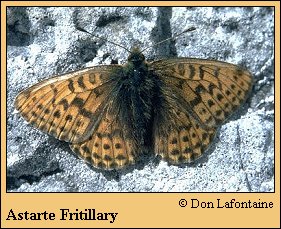 |
 

 |



Astarte Fritillary (Boloria astarte [Doubleday & Hewitson])
Wing span: 1 5/8 - 2 inches (4.2 - 5.1 cm).
Identification: Wings orange-brown; upperside with dark markings heaviest near base of wings; underside of hindwing with white median and postmedian bands; submarginal and postmedian rows of small black spots.
Life history: Males patrol for females with a fast flight close to the ground, near host plants. Females lay eggs on or near the host plant.
Flight: One flight from June-August.
Caterpillar hosts: Spotted saxifrage (Saxifraga bronchialis).
Adult food: Flower nectar.
Habitat: Windswept, barren, alpine and arctic ridges.
Range: Very uncommon. Western mountains from Alaska and Yukon south through British Columbia and Alberta to northern Washington and northern Montana.
Conservation: Populations in the contiguous United States are very limited and all should be conserved.
The Nature Conservancy Global Rank: G5 - Demonstrably secure globally, though it may be quite rare in parts of its range, especially at the periphery.
Management needs: None reported.
References:
Scott, J. A. 1986. The butterflies of North America. Stanford University Press,
Stanford, Calif. 583 pages, 64 color plates.
Tilden, J. W. 1986. A field guide to western butterflies. Houghton-Mifflin Co.,
Boston, Mass. 370 pages, 23 color plates.
Author: Jane M. Struttmann
State and Regional References:
Layberry, R.A., Hall, P.W. & Lafontaine, D.J., 1998. The Butterflies of
Canada. University of Toronto Press, Toronto, ON. 280 pp.